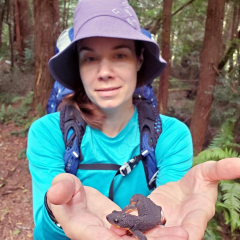Do Salamanders Smell Better Than Fish? Structure and Function of the Nose in Lungless Salamanders

Did you know that many animals undergo dramatic changes during their lives? These changes often help the animal function in a new environment. Many of native California salamanders go through a huge transformation from aquatic babies (larvae) to land-living adults, and so does their sense of smell! Explore the changes that researchers have recently discovered in lungless salamanders as they transition from aquatic larvae to terrestrial adults. Understanding how these salamanders smell helps us learn more about how animals adapt to life on land!
Our presentation will explore why olfaction (sense of smell) is so important to lungless salamanders, including ones that live in Humboldt county. We will describe how the organs that detect chemicals change in plethodontid salamanders as they transition from aquatic larvae to terrestrial adults. Our study focuses on the olfactory organs of six species, finding that while the general structure of the nose was similar across species, one species (Desmognathus aureatus) showed an usual change in nose shape after metamorphosis. Our study also looked at the expression of specific proteins which are crucial for detecting smells. We discovered that most proteins are required across all life stages, but where they are expressed is variable in some species. These findings highlight both structural and molecular differences in how salamanders sense smells, depending on their life stage and environment.
Presented by:
Karen Kiemnec-Tyburczy Ph.D.
Karen is an assistant professor in the Biological Sciences Department at Cal Poly Humboldt. She grew up in Oregon received her Bachelor's of science and her Ph.D. from Oregon State University and spent several years doing research at Cornell University before joining the Humboldt faculty. Her research focus is evolutionary biology. Most of her work focuses on the evolution of frogs and salamanders that are native to California and North Carolina. She is investigating evolutionary questions across multiple scales, from genes to development to behavior. She also teaches courses such as Genetics and Animal Development.
John Reiss Ph.D., Professor of Zoology, Department of Biological Sciences Cal Poly Humboldt
Born and raised in Southern California, John completed his BA in Biology and Environmental Studies at UC Santa Cruz, then moved east to do his MA and PhD at the Museum of Comparative Zoology at Harvard University. After postdoctoral studies at the University of Arizona, Tucson, he came to Humboldt in Fall 1997.
John's research focuses on the evolution, ecology and developmental morphology of amphibians, especially the origins and diversification of the metamorphic patterns seen in living amphibians. His graduate students have worked on a wide variety of topics relating to amphibians, including olfactory morphology, gill structure, population studies, environmental control of neoteny, and chytrid fungal disease. John is also interested in the history, philosophy, and theory of biology, especially evolutionary biology.



